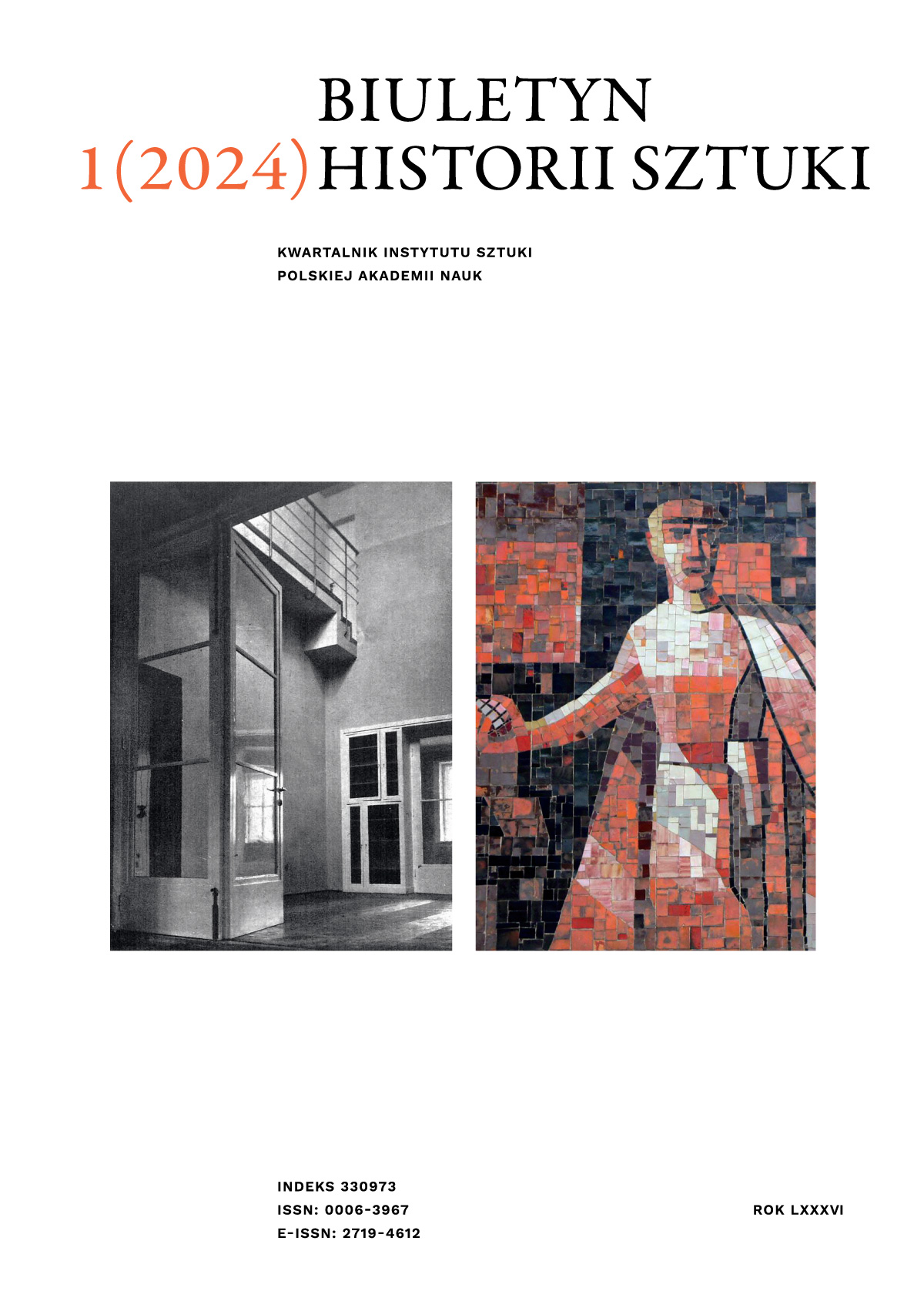Modalities of Pictorial Time. Morandi and Photography
Łukasz Kiepuszewski
kuki.k@wp.plAdam Mickiewicz University Poznań (Poland)
https://orcid.org/0000-0001-5750-0928
Abstract
This text attempts to use photographic images as source testimony concerning the creative process employed by Giorgio Morandi (1890–1964) and to use them as a comparative medium to trace. A series of photographs taken by Luigi Ghirri in 1989 reveals the phenomenological parameters of a studio that was the artist’s living space and the locus of his painting practice. In the photographer’s view, the studio has the characteristics of an optical chamber for observing phenomena related to the objects of study. The main part of the essay focuses on a comparative analysis of the 1964 Still Life with a photograph of objects related to this work. While a photograph has the temporal characteristics of a testimony, a painted image, due to its immersion in the manual procedure of its execution, possesses a temporality that accentuates the present-time quality of the perceptual event.
Keywords:
Giorgio Morandi, Luigi Ghirri, painting, time, photographyReferences
Ajello, Epifanio. „The Photographer and the Painter: Some Observations around the Things of Giorgio Morandi and Luigi Ghirri”. W: Luigi Ghirri and the Photography of Place, redakcja Maria Spunta, Jacopo Benci, 225–250. Oxford: Peter Lang, 2017.
Google Scholar
Bergstein, Mary. „«The Artist in His Studio»: Photography, Art and the Masculine Mystique”. Oxford Art Journal 18, nr 2 (1995): 45–57.
DOI: https://doi.org/10.1093/oxartj/18.2.45
Google Scholar
Boehm, Gottfried. Die Sichtbarkeit der Zeit. Studien zum Bild in der Moderne (eikones). Redakcja Ralph Ubl. Paderborn: Brill-Fink, 2017.
DOI: https://doi.org/10.30965/9783846762745
Google Scholar
de Duve, Thierry. „Time Exposure and Snapshot: The Photograph as Paradox”. October, nr 5 (1978): 113–125.
DOI: https://doi.org/10.2307/778649
Google Scholar
Folon, Jean-Michel. Luce di Morandi, La Donazione Folon al Museo Morandi. Wstęp Marilena Pasquali. Bologna: Museo Morandi, 1999.
Google Scholar
Ghirri, Luigi. Atelier Morandi, saggio di Giorgio Messori. Bari: Palomar, 2002.
Google Scholar
Ghirri, Luigi. „Una luce sul muro”. W: Niente di antico sotto il sole, redakcja Paolo Costatini, Giovanni Chiaramonte, 165–177. Torino: SEI, 1997.
Google Scholar
Giorgio Morandi. Tacita Dean, Semplice come tutta la mia vita. Redakcja Massimo Mininni et al. Milano: Skira, 2016.
Google Scholar
Heidegger, Martin. „Czym jest metafizyka?” W: id., Znaki drogi, tłumaczenie Krzysztof Pomian, 9–24. Warszawa: Aletheia, 1995.
Google Scholar
Il senso delle cose: Luigi Ghirri, Giorgio Morandi. Redakcja Luigi Ghirri, Giorgio Messori, Carlo Zucchini. Reggio Emilia: Diabasis, 2006.
Google Scholar
James, William. „The Perception of Time”. The Journal of Speculative Philosophy 20, nr 4 (1886): 392.
Google Scholar
Joel Meyerowitz: Morandi’s Objects. Redakcja Maggie Barrett, Joel Meyerowitz. Bologna: Damiani, 2016.
Google Scholar
Leopardi, Giacomo. Myśli. Tłumaczenie i opracowanie Stanisław Kasprzysiak. Wprowadzenie Emanuele Severino. Kraków: Oficyna Literacka, 1997.
Google Scholar
Leopardi, Giacomo. Zibaldone. Notatnik myśli. Tłumaczenie i opracowanie Stanisław Kasprzysiak. Warszawa: Czuły Barbarzyńca Press, 2016.
Google Scholar
Liberman, Alexander. The Artist in His Studio. New York: Viking Press, 1960.
Google Scholar
March Niedermayr, Brigitte. Transition Giorgio Morandi. Are you Still There. Redakcja Gianfranco Maraniello. New York: Rizzoli, 2016.
Google Scholar
Merleau-Ponty, Maurice. Widzialne i niewidzialne. Tłumaczenie Małgorzata Kowalska. Opracowanie Jacek Migasiński. Warszawa: Fundacja Aletheia, 1996.
Google Scholar
Museo Morandi. Catalogo generale. Redakcja Marilena Pasquali, Lorenza Selleri. Milano: Silvana, 2004.
Google Scholar
Ragghianti, Carlo Lodovico. Bologna cruciale 1914: e saggi su Morandi, Gorni, Saetti. Bologna: Calderini, 1982.
Google Scholar
Safranski, Rüdiger. Czas. Co czyni z nami i co my czynimy z niego. Tłumaczenie Bogdan Baran. Warszawa: Czytelnik, 2017.
Google Scholar
Smolarz, Bruno. Giorgio Morandi. Les jours et les heures. Paris: Arlea, 2016
Google Scholar
Authors
Łukasz Kiepuszewskikuki.k@wp.pl
Adam Mickiewicz University Poznań Poland
https://orcid.org/0000-0001-5750-0928
Łukasz Kiepuszewski is an art historian, a professor at the Institute of Art History of the Adam Mickiewicz University in Poznań. His selected publications include: Obrazy Cézanne’a. Między spojrzeniem a komentarzem [Cézanne’s Paintings. Between a Gaze and a Commentary] (2005); Niewczesne obrazy. Nietzsche i sztuki wizualne [Untimely Images. Nietzsche and the Visual Arts] (2013); as the editor: Historia sztuki po Derridzie [Art History after Derrida] (2006); as the coeditor: Obrazy mocne – obrazy słabe [Strong Images – Weak Images] (2018); Obraz jako obiekt teoretyczny [Image as a Theoretical Object] (2020); Powierzchnia i tło obrazu [The Surface and the Background of a Painting] (2022).
Statistics
Abstract views: 431PDF downloads: 310
License

This work is licensed under a Creative Commons Attribution 4.0 International License.
The author grants the publisher a royalty-free non-exclusive licence (CC BY 4.0) to use the article in Biuletyn Historii Sztuki, retains full copyright, and agrees to identify the work as first having been published in Biuletyn Historii Sztuki should it be published or used again (download licence agreement). The journal is published under the CC BY 4.0 licence. By submitting an article, the author agrees to make it available under this licence.
In issues from 1(2019) to 4(2022) all articles were published under the CC BY-NC-ND 4.0 licence. During this period the authors granted the publisher a royalty-free non-exclusive licence (CC BY-ND 4.0) to use their article in Biuletyn Historii Sztuki, retained full copyright, and agreed to identify the work as first having been published in our journal should it be published or used again.






